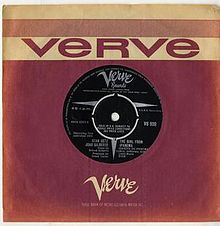The Girl from Ipanema
Single by Stan Getz and João Gilberto
from the album Getz/Gilberto
Released 25 July 1964
Genre
Bossa nova jazz
Label Verve
Songwriter(s)
Antônio Carlos Jobim & Vinícius de Moraes Norman Gimbel (English lyrics)
Producer(s) Creed Taylor
“Garota de Ipanema” (“The Girl from Ipanema”) is a Brazilian bossa nova jazz song. It was a worldwide hit in the mid-1960s and won a Grammy for Record of the Year in 1965. It was written in 1962, with music by Antônio Carlos Jobim and Portuguese lyrics by Vinicius de Moraes. English lyrics were written later by Norman Gimbel.
The first commercial recording was in 1962, by Pery Ribeiro. The 1964 single featuring Astrud Gilberto and Stan Getz became an international hit. This had been shortened from the version on the album Getz/Gilberto (recorded in March 1963, released March 1964) which had also included the Portuguese lyrics sung by João Gilberto. In the US, the single peaked at number five on the Billboard Hot 100, and went to number one for two weeks on the Easy Listening chart. Overseas it peaked at number 29 in the United Kingdom, and charted highly throughout the world.
Numerous recordings have been used in films, sometimes as an elevator music cliché. It is believed to be the second most recorded pop song in history, after “Yesterday” by The Beatles. The song was inducted into the Latin Grammy Hall of Fame in 2001. In 2004, it was one of 50 recordings chosen that year by the Library of Congress to be added to the National Recording Registry. In 2009, the song was voted by the Brazilian edition of Rolling Stone as the 27th greatest Brazilian song.
Above: Helô Pinheiro, the woman who inspired the song, in 2006.
Ipanema is a fashionable seaside neighborhood located in the southern region of the city of Rio de Janeiro.
The song was composed for a musical comedy titled Dirigível (Blimp), then a work-in-progress of Vinícius de Moraes. The original title was “Menina que Passa” (“The Girl Who Passes By”); the first verse was different. Jobim composed the melody on his piano in his new house in Rua Barão da Torre, in Ipanema. In turn, Moraes had written the lyrics in Petrópolis, near Rio de Janeiro, as he had done with “Chega de Saudade” (“No More Blues”) six years earlier.
During a recording session in New York with João Gilberto, Antonio Carlos Jobim and Stan Getz, the idea of cutting an English-language version came up. Norman Gimbel wrote the English lyrics. João’s wife, Astrud Gilberto, was the only one of the Brazilians who could speak English well and was chosen to sing. Her voice, without trained singer mannerisms, proved a perfect fit for the song.
The song was inspired by Heloísa Eneida Menezes Paes Pinto (now known as Helô Pinheiro), a seventeen-year-old girl living on Montenegro Street in Ipanema. Daily, she would stroll past the Veloso bar-café, not just to the beach (“each day when she walks to the sea”), but in the everyday course of her life. She would sometimes enter the bar to buy cigarettes for her mother and leave to the sound of wolf-whistles. In the winter of 1962, the composers saw the girl pass by the bar. Since the song became popular, she has become a celebrity.
Legal disputes
In 2001, the song’s copyright owners (heirs of their composer fathers) sued Pinheiro for using the title of the song as the name of her boutique (Garota de Ipanema). In their complaint, they stated that her status as The Girl from Ipanema (Garota de Ipanema) did not entitle her to use a name that legally belonged to them. Public support was strongly in favor of Pinheiro. A press release by Jobim and Moraes, the composers, in which they had named Pinheiro as the real Girl from Ipanema (Garota de Ipanema) was used as evidence that they had intended to bestow this title on her. The court ruled in favor of Pinheiro.
In a separate legal dispute, Astrud Gilberto sued Frito-Lay for trademark infringement for using the song in a TV ad for its baked potato chips. Gilberto argued that
as the result of the huge success of the 1964 recording, and her frequent subsequent performances of “Ipanema,” she has become known as The Girl from Ipanema and is identified by the public with the 1964 recording. She claims as a result to have earned trademark rights in the 1964 recording, which she contends the public recognizes as a mark designating her as a singer. She contends, therefore, that Frito-Lay could not lawfully use the 1964 recording in an advertisement for its chips without her permission.
In Oliveria v. Frito-Lay Inc. (2001), her claims were rejected by the United States Court of Appeals for the Second Circuit
From Wikipedia, the free encyclopedia


